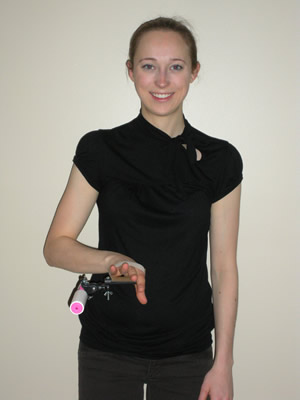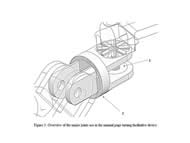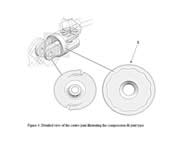ABSTRACT
Individuals with decreased hand functioning, as the result of diagnoses such as arthritis, cerebral palsy, and stroke often have difficulties with fine motor activities. Reading, specifically the act of page-turning, can be one such activity that is greatly affected. A novel assistive device to assist individuals with such difficulties has been developed by the authors of this paper, the manual page turning facilitative device, to address this problem. This paper describes the current options in assistive devices for page-turning and the need for an efficient and effective device, a description of the manual page turning facilitative device, and positive feedback from potential clients and rehabilitation professionals on the usability of the device, particularly on its portability, comfort, promotion of independence, and effectiveness.
KEYWORDS
Manual, page turner/turning, hand, adhesive
BACKGROUND
Individuals with diagnoses such as arthritis, cerebral palsy, stroke, and acquired brain injury often experience difficulties with fine motor tasks due to poor hand functioning, which may be a result of spasticity, contractures, joint subluxation, or structural deformities in the hand (1), (2). Reading is an example of a meaningful activity that may be difficult for these populations due to the requirement of fine motor skill to turn a page. Reading books, magazines, or newspapers is important in various domains of daily living, such as work, school, and leisure.
There are some limited commercially available options available to address this problem, such as automatic page turners, electronic book readers, and using a rubber-tipped rod in a universal cuff. However, electronic automatic page turners and book readers can be prohibitively expensive and sometimes prove to be difficult to load media for someone with an upper extremity disability. Moreover, automatic page turners are often bulky and lack portability. While the electronic reader is portable, feedback from users indicate that eye strain is a problematic issue. Although using a rubber-tipped rod in a universal cuff attached to the palm of one’s hand is an inexpensive and portable option, feedback from users and occupational therapists note its inefficiency, as it often takes multiple tries to turn one page.
With Canada’s aging population, decreased hand functioning from arthritis or stroke will increasingly become an issue affecting people’s abilities to engage in fine motor tasks such as reading. It is estimated that by 2031, the number of people living with arthritis will increase to 6.5 million, an increase of 124% from reported numbers in 1991 (3). Therefore, there exists a need for a portable, inexpensive page-turning device that requires limited fine motor movement in order to assist the aforementioned populations in being able to read bound material.
METHODOLOGY
Prototype Design
The manual page turning device includes three components as shown in Figure 1.The first component, the Universal Cuff Attachment piece (label 1 in Figure 1) can slot into the pocket of a standard universal cuff for children and adults (as shown in Figure 2). This secures the device to a user’s hand. Universal cuffs are commonly prescribed by rehabilitation professionals as an adaptive aid to assist in holding items such as utensils, brush, or pencil enabling the a client with poor hand functioning and a weak grasp to participate in basic activities of daily living. They are also commercially available at many rehabilitation and medical equipment suppliers.
The second component (label 2 in Figure 1) provides a series of joints allowing three-axis adjustability for the specific physical needs (i.e., contractures) of the user. The Lower Joint (label 2a in Figure 1) allows for vertical motion through rotation of about 180 degrees. This vertical motion allows the user to adjust the height of the adhesive tape roll with respect to their hand. This joint is held together with the use of a wing-nut and bolt combination. The Centre Joint (Figure 4), is a compression fit-type joint (label 2 in Figure 3), which allows for rotational configurations. The Upper Joint (label 2c in Figure 1) includes a toothed and beveled patterns (label 1 in Figure 4), used when predetermined rotation intervals are desired.
Configurability is a critical feature as it promotes universality for a range of diagnoses and abilities. For instance clients with arthritis will often have subluxation of the extensor tendons contributing to ulnar drift of the metacarpophalangeal joints (4). Clients with cerebral palsy may have a different appearance as they commonly have a predominant flexed wrist position due to the spasticity in their flexor muscles (4). The second component may be configured so that the central axis of the adhesive tape roll being perpendicular to the direction of the page turning, generally parallel to the spine or fold in the book.
The third component is also known as an “Adhesive Roller Cylinder” (label 3 in Figure 1). This component is used to support an adhesive tape roll, which slides on as a sleeve. It is secured by a washer (label 4 in Figure 1) whose diameter is just larger than that of the inner diameter of the adhesive tape roll. This provides a rotating adhesive surface which makes contact with the page of the user’s reading material.
Use of the Manual Page Turning Facilitative Device
To turn a page, the user needs to only make the adhesive roller contact the page they wish to turn and laterally move their arm in the desired direction of page turning. Figure 2 illustrates a common way to use the device. The adhesive tape surface rotates about the Adhesive Roller Cylinder to ensure that there is always sufficient area in contact with the page such that it will not be released until the page is turned. Continued lateral movement (in the direction the page was turned) will ultimately result in the release of the pages as the binding of the reading material constrains the page’s movement and contact with the adhesive surface is lost.
The adhesivity of the adhesive tape roll is such that it just exceeds that required to lift a page of average weight and does not require significant effort to release said page from the adhesive surface. An adhesive tape roll is employed as the user could remove the top layer of the roll, exposing a fresh adhesive surface as needed over time. An adhesive tape roll used with this device would encompass a number of lengths of fresh adhesive tape such that it would only need to be replace periodically depending on frequency of use.
Preliminary Trials
Five clients with limited hand functioning including a 6 year old male with hypotonia, 13 year old female with developmental coordination disorder, 19 year old female with cerebral palsy, and 86 and 70 year old females with rheumatoid arthritis were interviewed using a semi-structured format. The participants were encouraged to provide feedback in terms of comfort, weight, effectiveness and marketability once video-recorded test sessions took place. These sessions occurred in a natural environment and included a variety of reading materials. Each session first involved the client being properly fitted with the prototype prior to using it with reading material of their choice. A second-generation prototype has since been produced with the use of common machining techniques as well as stereolithography.
Four professionals in the rehabilitation field including a hand therapist from a local hospital, a nurse practitioner from the Mississauga Community Care Access Centre, and two professors from the Department of Occupational Science and Occupational Therapy at the University of Toronto were also interviewed. Questions surrounded topics including strengths, limitations, versatility, clinical implications, and cost-effectiveness. Qualitative content analysis was used to analyze the data and emergent themes were identified.
DISCUSSION
Observation of participants using the page turner indicated its effectiveness in adhering to a single page and subsequently releasing the page with lateral upper extremity movement. Each of the participants was able to use the page turner effectively after two to three minutes of practice with the device. A content analysis of the semi-structured interview responses yielded the following themes:
- Portability
- Comfort/ease of use
- Enabling independence
- Effectiveness
The individual with cerebral palsy was a university student and thus reading and studying from textbooks was a large part of her daily life. She struggled with turning pages due to contractures and limited range of motion. She commented that the device “is portable...and requires minimal assistance, if any, so it encourages independence.” Independence is important for many people, including individuals with disabilities.
The individuals with DCD and hypotonicity were both younger children who experienced difficulty with the fine motor aspect of page turning. Both individuals were excited to try our device to enable them to participate in reading along with their peers. The outcome of these evaluations was also positive. Interestingly, the child with low tone had no difficulty releasing the sticky adhesive from the page. It was anticipated that this might be difficult due to his low tone and reduced strength. One of the children commented that “it made reading a lot easier” and that it was “awesome.” Enabling children to read helps them to progress in school and not fall behind their peers.
The individuals with rheumatoid arthritis both found the design to be comfortable and liked that the angle of the adhesive roller was adjustable to their particular contracture. One individual commented that the design is “portable and lightweight” while the other individual noted that “...conceptually, it works!” Both individuals commented that they could see themselves using this device in the future.

The rehabilitation professionals were also very positive about the design and the potential for clinical use. An occupational therapist working in hand therapy for over 25 years commented that “this is the best page turner I have ever used.” When asked about the clinical implications one professional in the field of assistive technology commented, “I strongly feel that this new product will have a great impact on the lives of people with disabilities, and that this technology will result in great commercial benefit...”
FOLLOW-UP
Responding to this feedback, we have filed for a utility patent with the US Patent and Trademark Office and look forward to the opportunity to further develop and market this innovative and effective page turning device.
REFERENCES
- Francis, H. P., Wade, D. T., Turner-Stokes, L., Kingswell, R. S., Dott, C. S., & Coxon, E. A. (2004). Does reducing spasticity translate into functional benefit? An exploratory meta-analysis. Journal of Neurology, Neurosurgery and Psychiatry, 75, 1547-51.
- Adams, J., Burridge, J., Mullee, M., Hammond, A., & Cooper, C. (2004). Correlation between upper limb functional ability and structural hand impairment in an early rheumatoid population. Clinical Rehabilitation, 18(4), 405-13.
- Badley, E. M., & Wang, P. P. Arthritis and the aging population: Projections of arthritis prevalence in Canada 1991 to 2003. The Journal of Rheumatology, 25(1), 138-44.
- Pedretti, L. & Early, M. B. (2006). Occupational therapy: Practice skills for physical dysfunction (6th ed.). St. Louis: Mosby
CONTACT INFORMATION OF FIRST AUTHOR
Melissa Highland
1336 Outlook Terrace,
Oakville, ON
L6M 2B9
905-469-0936



